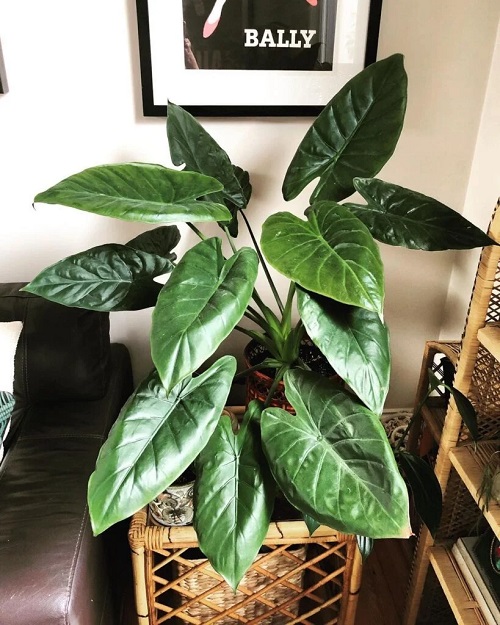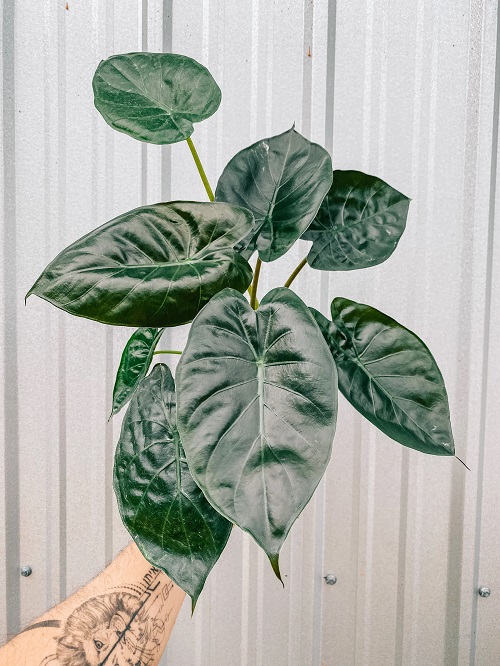Alocasia Wentii – a gorgeous specimen that stands out with its evergreen leaves! A must have for any plant enthusiast!

Alocasia Wentii boasts arrowhead-shaped leaves with intricate veins and a deep green hue. The elongated, wavy edges of its leaves give it an elegant and exotic appearance. Ready to nurture this stunning plant to perfection? Read on!
Learn all about Alocasia Silver Dragon here
Alocasia Wentii Information
Brief History and Origin of the Plant
Alocasia Wentii is native to Southeast Asia’s lush and tropical rainforests. The plant’s scientific name, Alocasia Wentii, pays tribute to Mr. Went, a Dutch botanist who significantly contributed to the study of tropical plants.
It was during botanical explorations in Southeast Asia that Mr. Went encountered this remarkable species, leading to its introduction to the wider botanical world.
- Exquisite Foliage: Alocasia Wentii is popular for its remarkable foliage. Its large, arrowhead-like leaves have intricate veining patterns and a glossy, dark green color. The unique blend of colors and textures on its leaves makes it a visually captivating addition to any indoor space.
- Architectural Elegance: The plant’s upright growth habit and striking leaf structure lend an architectural elegance to interior spaces. Its leaves can grow to an impressive size, creating a bold focal point in any room.
- Tropical Aesthetics: Houseplant enthusiasts like Alocasia Wentii because it brings a touch of the tropics into their homes. Its appearance evokes the lush beauty of tropical rainforests, making it an ideal choice for those looking to create a tropical oasis indoors.
- Indoor Adaptability: While it hails from tropical regions, Alocasia Wentii can adapt well to indoor environments, provided it receives the right care. Its preference for bright, indirect light and regular watering fits well with typical indoor gardening conditions.
- Collector’s Appeal: Plant collectors appreciate its rarity and uniqueness within the Alocasia genus.
Black Dragon Snake Plant Care and Growing Guide
Propagating Alocasia Wentii
Stem Cuttings Propagation (Easiest Method):
- Start by selecting a healthy and mature Alocasia Wentii plant that you wish to propagate. Ensure that the parent plant has at least two or more bulbs or stems that can be separated.
- The best time to propagate Alocasia Wentii is during its active growing season, which is typically in the spring or early summer. Avoid dividing the plant during its dormant period in winter.
- Gently remove the parent plant from its pot, being careful not to damage the roots or bulbs.
- Examine the root system and bulbs. You can carefully separate the bulbs or stems, ensuring that each division has both roots and stems. Use clean pruning shears or a knife for precise cuts.
- Prepare pots or containers with well-draining potting mix. Plant each division into its own pot, ensuring that the bulbs or stems are at the appropriate depth. Lightly press the soil around the division to secure it in place.
- Water the newly potted divisions thoroughly to settle the soil and provide hydration. Ensure that the soil remains consistently moist but not waterlogged.
- Place the newly potted divisions in a location that provides bright, indirect light. Avoid direct sunlight, which can be harsh on young plants.
- Maintain a humid environment around the newly propagated plants. You can achieve this by misting them regularly or placing them on a humidity tray.
- Keep a close eye on the new divisions’ growth. They should start producing new leaves and establishing their root systems within a few weeks to months, depending on conditions.
Philodendron Sharoniae Care and Growing Guide
Best Pot Size for Growing Alocasia Wentii
Start with a small pot (8-10 inches) that’s slightly larger than the current root ball when the plant is young. Gradually increase the pot size as the plant grows, typically by 1-2 inches in diameter.
Requirements for Growing Alocasia Wentii

Sunlight
Alocasia Wentii thrives in bright, indirect light. This means it should receive ample light, but not direct sunlight. Place the plant near a north or east-facing window where it can receive filtered sunlight. You can use sheer curtains or blinds to diffuse the light further.
Direct sunlight can be too intense for Alocasia Wentii, and it may lead to leaf burn or damage. Therefore, it’s essential to protect it from direct sun exposure.
Soil
The soil for Alocasia Wentii should be well-draining. This means it should allow excess water to flow out and not become waterlogged.
Use a potting mix specifically formulated for tropical plants or create your own mix by combining potting soil with perlite or orchid bark for improved drainage.
The soil should also be rich in organic matter, which provides essential nutrients for the plant’s growth.
Gulf Stream Nandina Care and Growing Guide
Water
Alocasia Wentii prefers to be consistently moist, but not soggy. It’s important to maintain a balance in watering. Check the moisture level by inserting your finger into the soil. Water when the top inch (2.5 cm) feels dry.
During the plant’s dormant period, typically in winter, reduce watering as the plant’s growth slows down. Overwatering during this time can lead to root rot.
Temperature
Maintain a warm and consistent temperature range for Alocasia Wentii. Ideally, keep it between 65-90°F (18-31°C). Avoid exposing the plant to cold drafts, as sudden temperature drops can stress the plant and harm its growth.
Providing a stable temperature environment will help Alocasia Wentii thrive.
Humidity
High humidity is crucial for Alocasia Wentii, as it mimics its native tropical habitat. Use a humidity tray (a tray filled with water and pebbles with the pot placed on top) or a room humidifier to maintain a humid environment around the plant.
Everything About Growing Parsley from Division
Alocasia Wentii Care
Fertilization
Fertilizing your Alocasia Wentii is essential for providing it with the nutrients it needs to grow and thrive. Look for a balanced N-P-K ratio, such as 10-10-10 or 20-20-20.
During the growing season, which typically spans from spring to summer, dilute the fertilizer to half-strength and use it every 2-4 weeks. Remember, over-fertilizing can harm the plant.
Pruning and Maintenance
Inspect the plant regularly for yellowing or damaged leaves. These can occur naturally as the plant ages or due to environmental stress. Use clean and sharp scissors or pruning shears to trim away any yellow or damaged leaves. Make clean cuts to avoid injuring the remaining foliage.
14 Herbs You Should Never Buy But Grow Instead at Home
After pruning, wipe the remaining leaves with a damp cloth to remove dust and maintain their glossy appearance. Clean leaves also help the plant photosynthesize more efficiently.
Pests and Diseases
Regularly inspect the leaves and stems for any signs of pest infestation, such as tiny webs (spider mites) or cottony clusters (mealybugs).
If you notice pests, act promptly. Mix a solution of neem oil or insecticidal soap following the product’s instructions. Apply the solution to affected areas, ensuring good coverage. Reapply as needed until the pests are under control.
Preventing fungal diseases, like leaf spot, is essential. Ensure the plant has good air circulation to reduce humidity around the leaves.
If you observe any unusual spots or discoloration on the leaves, consider improving airflow and reducing humidity if necessary. Trim affected leaves if the issue persists.



